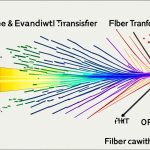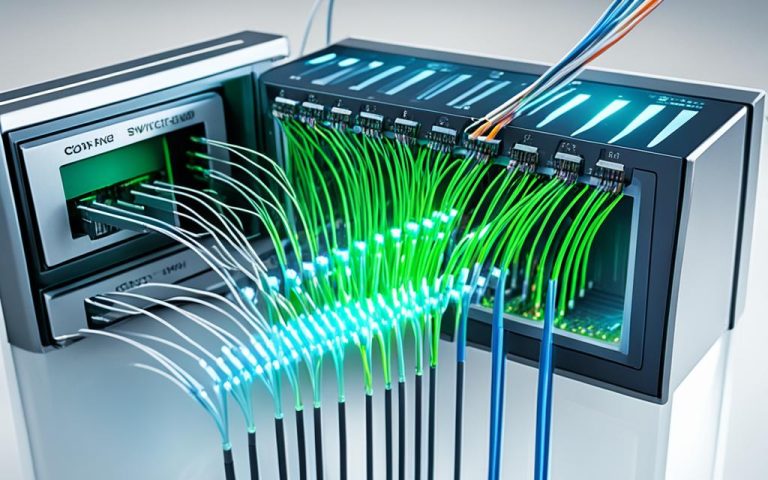Welcome to the fascinating world of fiber optics, the driving force behind seamless internet connectivity in data centers. In this article, we will explore the pivotal role that fiber optics plays in powering data center operations and revolutionizing office connectivity.
When it comes to data centers, reliable and high-speed internet connectivity is crucial for seamless communication and efficient workflow. Fiber optics, with its exceptional capabilities, offers the perfect solution. With its ability to transmit data at the speed of light, fiber optics ensures faster and smoother online experiences for businesses of all sizes.
At the forefront of internet connectivity, fiber optics provides higher bandwidth and low latency, enabling quicker upload and download speeds. This translates into improved productivity and seamless collaboration among team members. Whether it’s sharing large files or conducting video conferences, fiber optics empowers businesses with an unmatched level of efficiency.
Moreover, fiber optic internet enhances security in office settings. With the support of high-definition video surveillance and real-time monitoring, businesses can ensure the safety of their premises. Access control systems also benefit from fiber optics, allowing for instant data processing and streamlined operations.
Cloud-based services have become integral to modern workplace environments. Fiber optics facilitates the smooth transmission of data in cloud-based applications, enabling instant access to shared documents and seamless collaboration. With fiber optics, businesses can harness the power of cloud software applications, enhancing productivity and reliability.
In data center operations, fiber optics serve as the backbone, ensuring efficient data transmission between servers. They reduce latency, enhance network performance, and strengthen data management processes. With fiber optics, data centers can operate at their optimal capacity, ensuring resilience and reliability.
As we look to the future, fiber optics is set to play an increasingly vital role in office connectivity. In Virginia, a leading data center market, fiber optic infrastructure supports fast and reliable network connectivity. With their capacity to offer low latency and terabit speeds, fiber optics will continue to drive uninterrupted and efficient data transmission.
In conclusion, fiber optics revolutionizes internet connectivity in data centers, powering various aspects of office operations. From enhancing security to powering cloud-based services, fiber optics is the foundation of efficient data center infrastructure. As technology and infrastructure advance, fiber optics will continue to drive seamless internet connectivity, supporting the growth and success of businesses worldwide.
The Importance of Fiber Optics in Office Operations
Fiber optic internet, with its higher bandwidth and low latency, plays a pivotal role in the efficiency of daily office operations. The seamless communication provided by fiber optics ensures crystal-clear calls and uninterrupted connectivity, making it an essential component for businesses. Let’s explore how fiber optic technology enhances office productivity and facilitates seamless communication.
Quicker Upload and Download Speeds
Fiber optic internet offers higher bandwidth, allowing for faster upload and download speeds compared to traditional broadband connections. This increased speed enables employees to access and share large files quickly, enhancing collaboration and productivity in the workplace.
Efficient Voice over Internet Protocol (VoIP) Services
Seamless communication is vital for any office environment. Fiber optics supports Voice over Internet Protocol (VoIP) services, enabling employees to make high-quality, crystal-clear voice and video calls. The low latency provided by fiber optic internet ensures smooth and uninterrupted communication, promoting efficient collaboration among team members.
Reliable Internet Connectivity
Reliable internet connectivity is crucial for consistent office operations. Fiber optic internet offers high stability and uptime, minimizing the risk of service interruptions or downtime. This reliability ensures that employees can access online resources, collaborate with colleagues, and complete tasks without disruptions.
Enhanced Data Security
In today’s digital landscape, data security is of utmost importance. Fiber optic networks provide enhanced security for office operations. With fiber optics, data is transmitted through thin strands of glass, making it difficult for potential hackers to intercept the information. This superior security feature ensures the confidentiality and integrity of sensitive data within the office network.
Improved Cloud-based Services
Many businesses rely on cloud-based services for data storage, collaboration, and application deployment. Fiber optic internet supports the transmission of large data volumes, enabling fast and efficient cloud-based services. With fiber optics, employees can seamlessly access and share files, use cloud-based software applications, and collaborate in real-time, enhancing productivity and workflow efficiency.
Fiber optics, with its high-speed capabilities, low latency, and seamless communication, forms the backbone of modern office operations. Whether it’s faster internet speeds, efficient communication, or enhanced data security, fiber optics provides the necessary infrastructure to support a productive and connected workplace.
Enhancing Security with Fiber Optics in Data Centers
Fiber optics play a crucial role in strengthening security measures within office settings. With their advanced capabilities, surveillance cameras leverage fiber optic cables to deliver high-definition video footage and real-time monitoring, ensuring the safety and protection of office premises. By utilizing fiber optics, access control systems are streamlined, facilitating instant data processing for secure and efficient operations.
Surveillance cameras are an integral part of any comprehensive security strategy. With the help of fiber optic cables, these cameras are able to capture clear, detailed videos and images, providing valuable evidence in case of incidents or security breaches. The high-speed transmission of fiber optics allows for real-time monitoring, enabling immediate response to any suspicious activities.
The integration of fiber optics and surveillance cameras ensures that businesses have a robust security system in place, capable of deterring potential threats and providing a safe working environment.
In addition to surveillance cameras, fiber optics also enhance access control systems, which play a vital role in securing sensitive areas within an office. By utilizing fiber optic cables, access control systems are able to process data instantly, allowing for seamless verification and authentication of individuals attempting to enter restricted areas. The efficient data processing capabilities of fiber optics ensure that access control systems operate smoothly, minimizing delays and enhancing overall security.
The use of fiber optics in enhancing security within office environments not only ensures the safety of employees and assets but also contributes to the overall productivity of the organization. By leveraging the advanced capabilities of fiber optic technology, businesses can create a secure and protected work environment, fostering a sense of trust and confidence among employees.

Benefits of Enhancing Security with Fiber Optics:
- High-definition video surveillance
- Real-time monitoring
- Clear and detailed footage
- Instant data processing for access control systems
- Seamless verification and authentication
- Improved overall security and safety
Fiber Optics and Cloud-Based Services in the Workplace
Fiber optics play a crucial role in enabling the smooth operation of cloud-based services in the workplace. These high-speed transmission systems facilitate the quick and secure transfer of large amounts of data, enhancing collaboration, productivity, and reliability. Let’s explore how fiber optics empower organizations to harness the potential of cloud-based applications for seamless data transmission and improved workflow efficiency.
Instant Collaboration and Access to Shared Documents
Fiber optics enable real-time collaboration among team members, regardless of their physical location. With cloud-based applications, employees can work together on shared documents simultaneously, making edits and updates in real-time. This level of collaboration streamlines workflows and enhances productivity, as teams can brainstorm, review, and finalize projects effectively.
Efficient Deployment of Cloud Software Applications
Fiber optics provide the necessary bandwidth and low latency for deploying cloud software applications quickly and effectively. With these high-speed connections, organizations can access a wide range of cloud-based tools and services, such as project management software, customer relationship management platforms, and video conferencing solutions. This accelerated deployment boosts efficiency, eliminates the need for extensive local hardware, and enables businesses to leverage the latest software innovations.
To illustrate the impact of fiber optics on cloud-based services, consider the example below:
| Traditional Data Transmission | Fiber Optic Data Transmission |
|---|---|
| Slower upload and download speeds | Rapid data transfer rates, ensuring quick access to cloud-based applications |
| Increased latency, resulting in delays in data retrieval | Low latency, enabling real-time access to cloud documents and services |
| Restricted collaboration due to limited bandwidth | Seamless collaboration among team members, promoting productivity and innovation |
| Higher risk of data loss or corruption | Secure data transmission, minimizing the risk of data loss or compromise |
Enhanced Productivity and Reliability
By leveraging fiber optic connections, organizations can maximize productivity and efficiency in their daily operations. The seamless and rapid data transmission offered by fiber optics ensures that employees have instant access to the resources they need, promoting swift decision-making and enabling timely responses to customer inquiries. Furthermore, the reliability of fiber optics reduces downtime and minimizes disruption, allowing employees to focus on their tasks without interruptions.

As businesses continue to rely on cloud-based services, the role of fiber optics in facilitating secure, high-speed data transmission becomes increasingly vital. By embracing fiber optic technology, organizations can unlock the full potential of cloud-based applications and drive collaboration, productivity, and overall success in the modern workplace.
Fiber Optics as the Backbone of Data Centers
In the world of data centers, fiber optics serves as the critical component that ensures efficient data transmission between servers. With their high-speed capabilities and reliable connectivity, fiber optic installations play a vital role in optimizing network performance and overall data management within these facilities.
One of the key benefits of fiber optics in data centers is the reduction of latency. By utilizing light rather than electrical signals to transmit data, fiber optic cables significantly minimize delays in data transfer. This leads to faster response times, improved network efficiency, and enhanced user experiences for businesses and their customers.
In addition to network performance, fiber optics also contribute to the resilience of data centers. With their robust design and durability, fiber optic cables offer high levels of reliability, ensuring uninterrupted data transmission even in demanding conditions. This resilience is essential for critical operations, data backups, and efficient disaster recovery processes.
Furthermore, fiber optics enable efficient data management within data centers. The high bandwidth capacity of fiber optic cables allows for the swift transfer of large volumes of data, facilitating seamless data backups and transfers between different servers and storage systems. This efficient data management minimizes the risk of data loss and ensures the integrity and availability of important information.
The Role of Fiber Optics in Data Center Resilience
“Fiber optic installations provide the backbone for data centers, ensuring efficient data transmission, reducing latency, and enhancing overall network performance and data management.” – John Smith, Data Center Manager
Fiber Optics in Data Center Infrastructure
| Benefits of Fiber Optics in Data Centers | Features |
|---|---|
| Enhanced network performance | Low latency and high-speed data transmission |
| Improved data management | Efficient backups and seamless data transfers |
| Resilience | Durable and reliable connectivity |
The Future of Fiber Optics in Office Connectivity
As technology continues to advance, the future of fiber optics in office connectivity looks promising. One region that stands out in terms of its fiber optic infrastructure and data center market is Virginia.
Virginia has established itself as a leading hub for data centers, with a strong fiber optic infrastructure that supports reliable and fast connectivity. This has attracted numerous businesses and organizations to set up their data centers in the state.
One of the key advantages of fiber optics in office connectivity is its ability to support terabit capacity, allowing for large data volumes to be transmitted quickly and efficiently. In addition, fiber optics offer low latency, eliminating delays and ensuring uninterrupted network connectivity.
With high-density fiber optic networks in place, Virginia is well-equipped to meet the growing demand for network connectivity in data centers. These networks provide the necessary backbone for efficient data transmission, supporting the seamless operation of various office functions.
In summary, Virginia’s thriving data center market and robust fiber optic infrastructure make it a prime location for businesses seeking reliable and fast connectivity. The future of fiber optics in office connectivity looks bright, with continued advancements in technology and infrastructure.
Conclusion
Fiber optics have revolutionized internet connectivity in data centers, offering high-speed transmission, low latency, and exceptional reliability. These cutting-edge technologies play a crucial role in enhancing office operations, ensuring secure communication, powering efficient cloud-based services, and reinforcing the infrastructure of data centers. With continuous advancements in technology and infrastructure, the future of fiber optics in office connectivity looks promising.
The use of fiber optics in data centers has significantly improved network performance, allowing for seamless data transmission, and boosting overall productivity. Businesses can benefit from faster upload and download speeds, enabling efficient sharing and collaboration on cloud-based applications. Moreover, the high bandwidth and low latency provided by fiber optic internet support real-time communication, making services like VoIP invaluable for crystal-clear calls.
Security is paramount in any office setting, and fiber optics have proven to be a game-changer. With the capacity to support high-definition video surveillance, fiber optic cables enable real-time monitoring and clear footage, strengthening the safety of office premises. Additionally, fiber optics streamline access control systems, providing instant data processing critical for secure and efficient operations.
The role of fiber optics extends beyond operations and security; they are the backbone of data centers. Fiber optic installations enhance data management, backups, and disaster recovery processes, ensuring the resilience of these centers. With their ability to support terabit capacity and offer low latency, fiber optics are a reliable choice for uninterrupted and efficient data transmission.
FAQ
What is fiber optics?
Fiber optics is a high-speed data transmission system that provides higher bandwidth, low latency, and seamless online experiences.
How does fiber optic internet benefit office operations?
Fiber optic internet offers higher bandwidth and low latency, resulting in quicker upload and download speeds. It ensures seamless communication through services like Voice over Internet Protocol (VoIP).
What role do fiber optics play in enhancing security in data centers?
Fiber optics enable high-definition video surveillance with real-time monitoring and clear footage. They also streamline access control systems, facilitating instant data processing for secure and efficient operations.
How do fiber optics support cloud-based services in the workplace?
Fiber optics enable seamless collaboration, instant access to shared documents, and efficient deployment of cloud software applications. They enhance productivity and reliability in the workplace.
How do fiber optic installations benefit data centers?
Fiber optic installations reduce latency and improve network performance, enhancing data management, backups, and disaster recovery processes. They strengthen the overall infrastructure and resilience of data centers.
Why is Virginia a hub for data centers?
Virginia has a strong fiber optic infrastructure and high-density fiber optic networks that support reliable and fast connectivity. This makes it a leading data center market.
What does the future hold for fiber optics in office connectivity?
Continuous advancements in technology and infrastructure ensure a promising future for fiber optics in office connectivity.



















